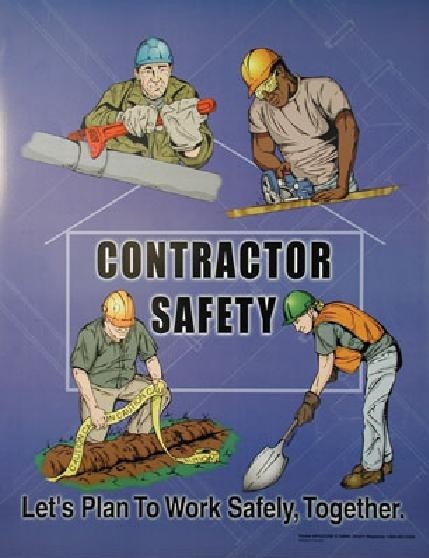Contractor Safety Rules

Contractors working on job sites must adhere to safety rules and regulations. These may be instituted through the Occupational Safety and Health Administration (OSHA)'s federal laws and must be followed. Additionally, there are often state and local laws that contractors must adhere to. Besides the mandated safety rules, you may want to implement your own additional rules. Having safety rules will help to ensure safety of your employees and also help ensure the safety of any visitors to a construction site.
Create a Safety Plan
Determine what your safety rules and procedures are going to be before you start work on a job site. Determine if your employees or subcontractors will need to submit to drug testing before starting work with your organization. Include this information in your safety rules, along with consequences if employees fail the drug test.
Safety rules should include having appropriate signage when working on buildings or roadways. OSHA requires barricades and traffic diversion signage when working on highways. Make sure your superintendents and employees are aware of these OSHA requirements.
Create emergency plans that include evacuation procedures. If your employees are working on a job site, make sure they understand what constitutes an emergency such as a fire or explosion. Be sure they understand how to evacuate the premises in case of an emergency. Include this information in your safety plan.
Give superintendents written copies of the safety rules so they can hand them out to new employees and also keep a copy on the job site.
Job Site Safety Rules
Contact a local Miss Utility office before excavating or digging in the ground for any type of cable, pipe or electrical line installation. Many states require this. Failure to contact Miss Utility will result in large fines. There is usually a time requirement for notifications. For example, some states require that you make the contact 48 hours before digging. This ensures that the organization has ample time to check whether you will be digging near buried lines or pipes.
Contractors' rules may require employees to wear personal protective equipment when working on a job site. Personal protective equipment includes hard hats, safety glasses and steel-toed boots. Hard hats may be required when working on job sites or in confined spaces such as attics or crawl spaces. Safety glasses may be required during procedures such as welding or working with nail guns. Steel-toed boots are often required on job sites, especially when working around heavy materials and equipment.
Contractors may require operators of heavy equipment to have special training before using the equipment. This includes equipment such as bulldozers and cranes. Specialized forklift training may be required.
Safety Follow-ups
Inform your superintendents that any accidents must be reported immediately. OSHA requirement 1960.70 requires that any fatal and catastrophic accidents be reported to the Office of Federal Agency Programs. Contractors must carry builder's risk and general liability insurance, and must notify their insurance agencies in the event of an accident. Contractors must also carry worker's compensation for their employees and report accidents to their insurance carrier.
Review safety plans frequently with superintendents and visit job sites regularly to ensure safety procedures and policies are being followed.
Create a Safety Plan
Determine what your safety rules and procedures are going to be before you start work on a job site. Determine if your employees or subcontractors will need to submit to drug testing before starting work with your organization. Include this information in your safety rules, along with consequences if employees fail the drug test.
Safety rules should include having appropriate signage when working on buildings or roadways. OSHA requires barricades and traffic diversion signage when working on highways. Make sure your superintendents and employees are aware of these OSHA requirements.
Create emergency plans that include evacuation procedures. If your employees are working on a job site, make sure they understand what constitutes an emergency such as a fire or explosion. Be sure they understand how to evacuate the premises in case of an emergency. Include this information in your safety plan.
Give superintendents written copies of the safety rules so they can hand them out to new employees and also keep a copy on the job site.
Job Site Safety Rules
Contact a local Miss Utility office before excavating or digging in the ground for any type of cable, pipe or electrical line installation. Many states require this. Failure to contact Miss Utility will result in large fines. There is usually a time requirement for notifications. For example, some states require that you make the contact 48 hours before digging. This ensures that the organization has ample time to check whether you will be digging near buried lines or pipes.
Contractors' rules may require employees to wear personal protective equipment when working on a job site. Personal protective equipment includes hard hats, safety glasses and steel-toed boots. Hard hats may be required when working on job sites or in confined spaces such as attics or crawl spaces. Safety glasses may be required during procedures such as welding or working with nail guns. Steel-toed boots are often required on job sites, especially when working around heavy materials and equipment.
Contractors may require operators of heavy equipment to have special training before using the equipment. This includes equipment such as bulldozers and cranes. Specialized forklift training may be required.
Safety Follow-ups
Inform your superintendents that any accidents must be reported immediately. OSHA requirement 1960.70 requires that any fatal and catastrophic accidents be reported to the Office of Federal Agency Programs. Contractors must carry builder's risk and general liability insurance, and must notify their insurance agencies in the event of an accident. Contractors must also carry worker's compensation for their employees and report accidents to their insurance carrier.
Review safety plans frequently with superintendents and visit job sites regularly to ensure safety procedures and policies are being followed.
- qde1013484adae61ed00254812e1381f7b.jpg